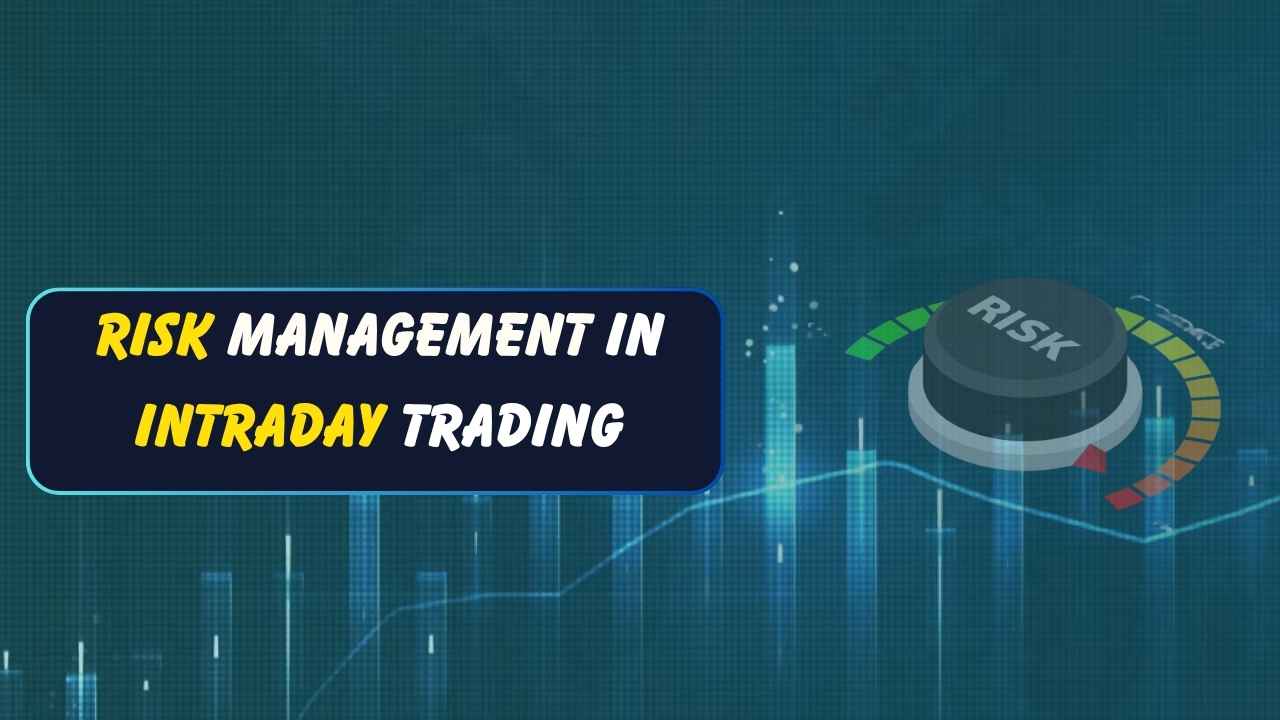Risk Management in Intraday Trading- Intraday trading is a high-risk, high-reward strategy where traders buy and sell assets throughout the day to capture quick profits. It carries significant risks due to sudden price fluctuations that can potentially wipe out initial investments. The risks amplify further when traders use leveraged products, futures, and options.
Unfortunately, many people enter day trading without understanding the risks involved or how proper risk management works. This comprehensive guide covers essential risk management strategies you need to know before starting your intraday trading journey.
What is Risk Management for Day Trading?
Intraday risk management is the systematic process of identifying, monitoring, and mitigating potential losses associated with day trading activities. It encompasses various techniques and strategies designed to preserve capital, reduce exposure to market risks, and optimize returns.
Given the high inherent risks of this strategy, effective risk management isn’t optional—it’s essential for day trading success.
Why Risk Management is Critical for Intraday Traders
Intraday trading carries substantially higher risks than other trading forms, making careful risk management crucial. Day traders face multiple challenges including exposure to significant market volatility, major economic events, high liquidity risks, lack of transparency, and psychological pressures arising from cognitive biases.
Successful intraday traders must maintain discipline and remain calm under pressure. Emotional decisions made during rapidly changing market conditions often lead to significant losses. Even experienced investors can fall prey to common emotional biases like fear and greed.
A 2024 study by the Securities and Exchange Board of India (SEBI) revealed alarming statistics about intraday trading risks. In FY23 alone, seven out of 10 day traders lost their initial investment and spent an additional 57% on trading costs beyond their losses. These figures underscore the critical importance of implementing robust risk management strategies.
Essential Risk Management Tools and Strategies
Day traders employ various tools and strategies to limit risks and enhance return potential. Here are the most effective ones you should master:
Stop-Loss Orders
A stop-loss order is the most fundamental risk management tool for intraday traders. It automatically triggers a buy or sell order when the asset price reaches a predetermined limit, cutting your losses short before they become unmanageable.
Real-world example: Rajesh buys 500 shares of Reliance Industries at ₹2,500 with a stop-loss at ₹2,475. When negative news about crude oil prices hits the market, Reliance drops rapidly. His stop-loss triggers at ₹2,475, limiting his loss to ₹12,500 (₹25 × 500 shares) instead of the ₹50,000 he would have lost if the stock had fallen to ₹2,400 by day’s end.
Take-Profit Orders
Take-profit orders work similarly to stop-losses but focus on securing gains. Once your target profit price is reached, the trade automatically executes, allowing you to close your position and lock in profits. This removes the emotional challenge of deciding when to exit winning trades.
Practical example: Priya enters a long position in TCS at ₹3,600 with a take-profit order at ₹3,650. When positive quarterly results push the stock higher, her order executes automatically at ₹3,650, securing ₹50 per share profit even though she was in a meeting and couldn’t monitor the market.
Trailing Stop-Loss
This advanced order type adjusts your exit strategy dynamically according to market movements. For instance, a 4% trailing stop-loss will increase your exit price by 4% as the stock price rises, protecting accumulated profits while allowing for further gains.
Case study: Amit buys HDFC Bank at ₹1,600 and sets a 3% trailing stop-loss. As the stock rises to ₹1,650, his stop-loss automatically adjusts from ₹1,552 to ₹1,600.50. When the price peaks at ₹1,680 and then reverses, his trailing stop at ₹1,629.60 triggers, securing a ₹29.60 profit per share instead of watching his gains evaporate.
Support and Resistance Levels
Support and resistance levels are critical reference points on price charts that help determine optimal entry and exit points. Support represents the price level below which a stock typically doesn’t fall, while resistance marks the ceiling beyond which it rarely rises.
Trading scenario: Infosys has shown consistent support at ₹1,550 over the past week and resistance at ₹1,600. A trader enters at ₹1,555 (just above support), sets a stop-loss at ₹1,545, and places a take-profit at ₹1,595. This setup offers a risk-reward ratio of 1:4 (risking ₹10 to gain ₹40), providing excellent risk management.
Risk per Trade
Never risk more than 1-2% of your total capital on any single trade. Calculate your per-trade risk by subtracting the stop-loss price from your entry price and multiplying by your position size.
Mathematical example: Neha has a trading capital of ₹5,00,000 and follows the 2% rule. Her maximum risk per trade is ₹10,000. If she wants to buy Wipro at ₹450 with a stop-loss at ₹440, her risk per share is ₹10. Therefore, she can buy a maximum of 1,000 shares (₹10,000 ÷ ₹10) without violating her risk management rule.
Risk-Reward Ratio
This metric measures potential gains against potential losses for each trade. Maintain a minimum risk-reward ratio of 1:2, meaning your potential profit should be at least twice your potential loss.
Success example: Vikram analyzes 10 trades with a 1:3 risk-reward ratio. He wins only 4 out of 10 trades but remains profitable overall. His 6 losing trades cost him ₹6,000 (₹1,000 each), while his 4 winning trades generate ₹12,000 (₹3,000 each), resulting in a net profit of ₹6,000 despite a 40% win rate.
Proven Risk Management Techniques
Set Realistic Win-Loss Parameters
Successful trading isn’t about winning every trade—it’s about overall profitability. You can lose most of your trades and still profit if your winning trades have sufficiently high profit margins.
Case study analysis: Two traders, Arun and Deepak, each make 20 trades in a month. Arun wins 14 trades (70% win rate) with an average profit of ₹500 and loses 6 trades with an average loss of ₹1,500, resulting in a net loss of ₹2,000. Deepak wins only 8 trades (40% win rate) with an average profit of ₹3,000 and loses 12 trades with an average loss of ₹1,000, resulting in a net profit of ₹12,000. This demonstrates that risk-reward ratio matters more than win rate.
Avoid Highly Volatile Stocks
While moderate volatility creates opportunities, extremely volatile stocks pose unnecessary risks. Since intraday positions close within the same day, large price swings against your position can result in devastating losses before you can react.
Warning example: During a major policy announcement, Yes Bank experiences 15% intraday swings. A trader enters a long position with ₹1,00,000 capital using 5x leverage. A sudden 8% drop against his position results in a ₹40,000 loss within minutes—40% of his capital gone in one trade. Sticking to stable large-cap stocks would have provided safer trading opportunities.
Follow the Market Trend
Most stocks move in tandem with broader market trends. Following the market direction generally offers better success rates than taking contrarian positions.
Market scenario: On a day when Nifty opens 2% down due to global market weakness, Kavita notices her watchlist stocks—Reliance, TCS, and HDFC Bank—all trending downward. Instead of buying against the trend, she takes short positions and profits from the continued downward momentum. By market close, Nifty is down 2.5%, and her short positions yield strong returns.
Implement Hedging Strategies
Hedging involves taking offsetting positions to limit maximum potential losses. This protective approach ensures your investment capital remains protected regardless of market outcomes.
Hedging example: Ravi is bullish on Tata Motors and buys 1,000 shares at ₹700. To protect against downside risk, he simultaneously buys 1 put option contract (lot size 1,000) with a strike price of ₹690 for a premium of ₹15 per share. If Tata Motors drops to ₹650, his stock position loses ₹50,000, but his put option gains approximately ₹40,000, limiting his net loss to ₹10,000 plus the premium paid.
Diversify Your Trading Portfolio
When holding multiple positions, diversify across different asset classes, sectors, and trading strategies. Distributing your capital reduces the impact of any single loss on your overall portfolio.
Diversification strategy: Sunil allocates his ₹3,00,000 trading capital across five different trades: IT sector (₹60,000 in Infosys), Banking (₹60,000 in ICICI Bank), Energy (₹60,000 in Reliance), Pharma (₹60,000 in Sun Pharma), and Auto (₹60,000 in Maruti). When the IT sector faces pressure, his losses are offset by gains in other sectors, resulting in a balanced daily performance.
Real-Life Risk Management Failure
The overconfident trader: Mohit had been trading successfully for three months with a ₹2,00,000 account that grew to ₹2,80,000. Feeling confident, he violated his risk management rules on a “sure thing” trade, investing ₹1,50,000 (more than 50% of his capital) in a single stock based on a tip. The trade went against him, and without a stop-loss, he held onto the losing position hoping for recovery. By day’s end, he lost ₹60,000—eliminating two months of profits in a single trade. This illustrates why discipline matters more than confidence.
Common Risk Management Mistakes to Avoid
Understanding what not to do is equally important:
- Moving stop-losses further away when trades go against you (hoping for recovery)
- Risking too much capital on “sure thing” trades that seem foolproof
- Abandoning risk management rules during winning streaks due to overconfidence
- Trading without predetermined stop-losses and hoping to exit manually
- Increasing position sizes after losses to “recover” quickly (revenge trading)
- Ignoring broader market conditions and economic news that affect all stocks
Building a Risk Management Plan
Create a comprehensive risk management plan before you start trading. Your plan should include:
- Maximum daily loss limit (e.g., 3% of total capital)
- Maximum position size per trade (e.g., 20% of capital)
- Preferred risk-reward ratio (minimum 1:2)
- Strategies for different market conditions (trending vs. range-bound)
- Clear rules for when to stop trading (after hitting daily loss limit)
Sample plan: Trading capital: ₹5,00,000 | Maximum risk per trade: 2% (₹10,000) | Daily loss limit: 5% (₹25,000) | Minimum risk-reward: 1:2.5 | Maximum positions: 3 concurrent trades | Stop trading after: 3 consecutive losses or daily limit reached.
Write down your plan and review it regularly. Having written rules makes it easier to maintain discipline during the emotional roller coaster of active trading.
The Psychology of Risk Management
Risk management is as much psychological as it is technical. Fear and greed are powerful emotions that can override rational decision-making.
Emotional discipline example: After three consecutive winning trades, Anita felt invincible and considered doubling her position size on the next trade. However, she referred to her trading journal and reminded herself of a previous instance where overconfidence led to significant losses. She stuck to her standard position sizing and avoided potential disaster when that fourth trade resulted in a loss.
Accept that losses are part of trading. No strategy wins 100% of the time. What separates successful traders from unsuccessful ones is how they manage losses and preserve capital during difficult periods.
Conclusion
Due to the high inherent risks of intraday trading, controlling potential losses, minimizing risks, and improving win rates are essential for success. With efficient risk management practices, traders can navigate fast-paced markets with confidence and consistency.
Beginners must master fundamental techniques like diversification, hedging, position sizing, and stop-loss implementation before risking significant capital. Remember that protecting your capital is more important than chasing profits—you can’t trade if you’ve lost all your money.
Start with small positions, follow your risk management rules religiously, and focus on consistent execution rather than home runs. Over time, disciplined risk management will become second nature, giving you the foundation for long-term trading success.
Learn More:
- Difference in Expense Ratio Between Direct and Regular Mutual Funds
- Best Small-Cap Index Funds
- 10 Debt Mutual Funds That Outperformed in the Last 1 Year with 10% to 24% Returns in 2025
- Best Tyre Stocks in India
- Best Healthcare Stocks in India
Risk Disclaimer
Important Notice: Intraday trading involves substantial risk and may not be suitable for all investors. The possibility exists that you could sustain losses in excess of your initial investment. Past performance is not indicative of future results.
Before deciding to trade, carefully consider your investment objectives, level of experience, and risk tolerance. Do not invest money that you cannot afford to lose. Be aware of all risks associated with intraday trading and seek advice from an independent financial advisor if you have doubts.
This content is solely for educational purposes. The securities and investments mentioned are not recommendations. All trading decisions are the sole responsibility of the individual trader.
Risk Management in Intraday Trading: FAQs
How does risk tolerance affect my day trading strategies?
Your risk appetite/tolerance determines the maximum risk you can comfortably bear. This determines the trading strategies and techniques you can follow to meet your objectives.
Why are stop-losses considered essential for any intraday trade?
Stop-loss orders are crucial for day traders as they limit the potential losses they can make. Since day trading exposes traders to the risks of sudden and large price movements, stop-losses are necessary to make a quick exit.
How can I manage my emotional biases when trading?
The key to managing emotional biases is to assess your behaviour and identify what factors can cloud your judgment. Some of the effective tips include maintaining a journal to record your trading activities, staying disciplined and seeking qualified help.







